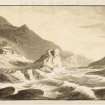Bressay, Noss Sound
Broch (Iron Age)
Site Name Bressay, Noss Sound
Classification Broch (Iron Age)
Canmore ID 1290
Site Number HU54SW 8
NGR HU 52808 40963
Datum OSGB36 - NGR
Permalink http://canmore.org.uk/site/1290
- Council Shetland Islands
- Parish Bressay
- Former Region Shetland Islands Area
- Former District Shetland
- Former County Shetland
Field Visit (9 July 1930)
Broch, Noss Sound. This ruined broch is situated at the extremity of a rocky headland close to the ferry between the islands of Bressay and Noss, its position being marked by a mound about 13 ft 6 in high. So large an accumulation of debris seems to indicate that considerable remains of the original structure still survive beneath the rectangular foundations of much later date by which the whole is surmounted. There is little of it visible now. But on the NW some 10 or 12 ft of the inner face of the wall can be seen rising to a height of three or four courses. Combining this evidence with a few faint indications of the line of the outer face which appear on the W, we may infer a wall-thickness of from 15 to 17 ft. Hibbert states that ‘within the foundation walls...were distinct cavities, each about twelve feet long, six feet broad, and about five feet deep’ (1822, 284). These were obviously cells. Only at the SW can any traces of them be observed to-day.
On the N or landward side at a distance of 25 ft 6 in from the broch itself, is a great bank of earth and stone, and at a further interval of 15 ft is a second bank, even more massive, both stretching all the way across the neck of the promontory. They are now uneven and broken, but one cannot exclude the possibility that, in part at least, they were originally walls of dry-stone masonry. The outer one may have been as much as 10 ft 6 in in thickness. Towards its E end its outer face was apparently defined by a line of large boulders set on edge. A wall about 40 ft in length seems to have run from the outer face of the broch to the head of the geo on the W, but it has been destroyed to the foundation, so that its exact character and purpose are no longer ascertainable. Adjoining this wall at the edge of the geo are what look like the ruins of a small cell or chamber, now practically destroyed.
RCAHMS 1946, visited 9 July 1930.
Field Visit (18 May 1968)
HU54SW 8 5280 4096.
(HU 52794097) Brough (OE)
OS 6" map, Shetland, 2nd ed., (1902).
The remains of a broch mound with two outer ramparts, as described by the RCAHMS.
Insufficient remains to determine the size of the broch.
Visited by OS (NKB) 18 May 1968.
Publication Account (2002)
HU54 4 NOSS SOUND HU/528410
This probable broch on Bressay I. stands near the end of a rocky headland with considerable outer defences. An earth and stone bank crosses the neck of the promontory 7.78 m (25.5 ft.) from the broch with a second, more massive one 4.58 m (15 ft.) beyond it: they may have originally been built stone walls up to 3.20 m (10.5 ft.) thick. There are some boulders on edge at the east end of the outer face of the outer bank, which may be part of it. The broch itself shows few of its structural features though the mound is still 4.12 m (13.5 ft.) high, and on the north-west several course of the inner face can be seen. Hibbert noted several "cavities" in the wall which must have been mural cells; each was about 3.66 m (12 ft.) long by 1.83 m (6 ft.) broad. Traces of one can be seen on the south-west. The wall of the broch seems to be about 4.58-5.19 m (15-17 ft.) thick.
Sources: 1. OS card HU 54 SW 8: 2. RCAHMS 1946, vol. 3, no. 1085, 3-4 and fig. 480 (plate): 3. Hibbert 1822, 284.
E W MacKie 2002
Note (3 March 2016 - 18 May 2016)
The broch overlooking Noss Sound on the E coast of Bressay occupies a low promontory which is also defended by two strong ramparts drawn in an arc across the neck to bar access from the N. The broch has been reduced to little more than a mound of rubble, and the outlying ramparts, which conventionally would be considered outworks to the broch, have also been reduced heavily reduced. Lying about 4.5m apart, the ramparts are of some size, and the occasional facing stones noted by RCAHMS investigators in 1930 led them to believe they represented two walls in the order of 3m in thickness. Most of the interior, currently measuring about 30m across (0.09ha), is occupied by the broch, and while it may have been reduced in size, it has probably not been significantly larger. The position of the entrance is not known. While the possibility that the ramparts were conceived here independently of the broch, the topographical character of this promontory, with shelving outcrops dropping down to the sea, is not directly comparable to the promontory forts more typically found in the Northern Isles, and in this case they are perhaps more likely to have been outworks to the broch.
Information from An Atlas of Hillforts of Great Britain and Ireland – 18 May 2016. Atlas of Hillforts SC4190












































